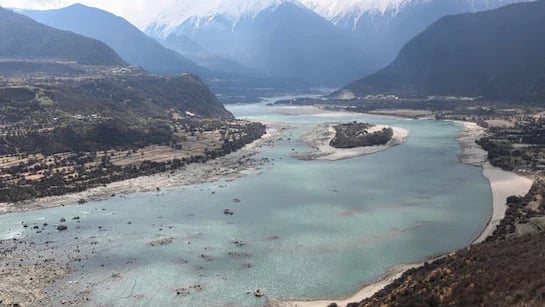A River Between Nations: Why India Is Worried About China’s New Mega Dam
High in the misty mountains of Tibet, the Yarlung Zangbo River begins a long and winding journey. By the time it flows into India’s Arunachal Pradesh and becomes the Brahmaputra, it has already carved through deep gorges, carried the memory of glaciers, and gathered the hopes of millions who live along its banks. But this river, once a shared source of life and livelihood, is fast becoming a new fault line between two of the world’s most powerful neighbors..
Thinkbrief
7/21/20253 min read


In July 2025, China began building what it calls the world’s largest hydropower dam on the Yarlung Zangbo. It is an ambitious and breathtaking project, five cascading hydropower stations that could generate nearly three times the electricity of the Three Gorges Dam, which was once considered the ultimate feat of human engineering. The Chinese government says it will help power homes, factories and cities, all while supporting its green energy goals.
But downstream in India, the mood is far from celebratory. There, the Brahmaputra is more than just a river. It is the beating heart of life in the Northeast, nourishing farms, quenching thirst, supporting biodiversity and giving identity to entire communities. And now, many fear that China’s actions could threaten that delicate balance.
For people in Assam and Arunachal Pradesh, the idea that someone upstream could control the flow of their river is not just unsettling, it is terrifying. What if water is suddenly held back? What if it is released without warning? Floods are already a yearly threat in Assam. Add the potential for man-made interference and the risks multiply. Droughts, flash floods or worse, entire towns and villages could be affected in ways that are hard to predict but impossible to ignore.
Indian leaders have expressed serious concern. Some have called the Chinese dam a potential water bomb, not in an alarmist sense, but out of real fear that the river could be used as a weapon, intentionally or otherwise. In times of peace this dam could strain trust. In times of tension it could become a new kind of pressure point in the already fragile relationship between the two countries.
A major part of India’s concern stems from the lack of transparency. China has not shared detailed plans with downstream nations, nor has it entered into any formal agreement on water sharing. In the past, during times of border conflict, China has withheld critical data about the river’s flow, leaving Indian authorities in the dark and people in vulnerable areas at greater risk.
And then there is the question of nature. The site where China is building this mega dam sits in one of the most earthquake-prone zones in the world. It is a breathtakingly beautiful, ecologically sensitive region. Building a structure of such massive scale there could pose enormous risks not only to the environment but to the communities living around it on both sides of the border.
In response to the growing threat, India is ramping up its own infrastructure plans. One plan involves building a large dam of its own on the Siang River, a major tributary of the Brahmaputra. It would serve as both a power source and a safeguard, ensuring India retains some control over the river before it flows further downstream into Bangladesh.
But even this approach raises questions. Large dams come with their own environmental and social costs, displacement of indigenous communities, threats to biodiversity and changes to the natural rhythm of the river. In seeking to protect itself, India risks repeating some of the same mistakes. It is a delicate balancing act and one that requires compassion, foresight and dialogue.
At the heart of all this is a shared river and a shared responsibility. Water knows no borders. It flows where the land allows, where gravity pulls, where nature decides. What happens upstream inevitably affects those downstream. And that makes cooperation, not confrontation, the only real solution.
Unfortunately, there is currently no binding treaty between China, India and Bangladesh on how to manage the Brahmaputra. Without a shared framework, each country is left to act in its own interest. That might work in the short term, but in the long run it only increases the chances of misunderstanding, mistrust and even disaster.
It does not have to be this way. There is still time to come together, to share data, consult each other and treat the river with the respect it deserves, not just as a resource to be used but as a lifeline to be protected. Because behind every drop of water in the Brahmaputra is a farmer in Assam, a child in Arunachal, a fisherman in Bangladesh, real people with real lives, connected by this ancient river that carries not just water but the weight of their hopes.
As India watches closely and prepares its response, one thing is clear. This is not just about power or policy. It is about people. About the land they love, the water they depend on and the uncertain future that lies ahead if we let division flow where unity should.